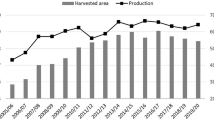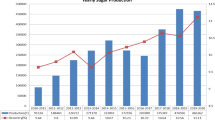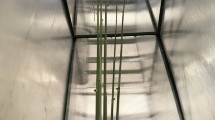Abstract
In Indonesia, sugarcane and sugar production during the last ten years (2010–2019) fluctuated considerably and showed a declining trend due to several reasons. The achievements of sugarcane production were mainly influenced by the availability of superior sugarcane varieties developed by the domestic sugarcane breeding programs. Historically, sugarcane breeding in Indonesia was started during the Dutch era in the late nineteenth century by Het Proefstation Oost Java (POJ) and the great achievements were the discovery of ‘wonder cane’ POJ 2878 and POJ 3016. Breeding activities carried out by the Indonesian Sugar Research Institute (ISRI), as the successor of POJ, are aimed to address different challenges including those arising from moving sugarcane production from paddy fields to dry and marginal lands, increasing ratoons, and managing climate change and biotic and abiotic stresses. Currently, ISRI is facing serious financial problems, which made breeding activities less optimal. Consequently, germplasm collection, number of crossing, seedling and clone selection, and the number of new released sugarcane varieties in the last 10 years decreased considerably. The decline of ISRI’s breeding activities has prompted several other institutions to carry out breeding programs, namely PT Gunung Madu Plantation, Jengkol Sugar Research Centre of PTPN X, Sukosari Research Centre of PTPN XI, and the Indonesian Sweeteners and Fiber Crops Research Institute (ISFCRI). In principle, the objective of all the breeding programs is to obtain superior varieties with the characteristics as expected by the cane growers such as high cane yield and sugar content, good ratooning ability, resistant to systemic diseases, and borer as well as drought tolerant. Currently, the majority commercial sugarcane varieties planted by cane growers are the old varieties that was released more than 10 years ago, and the most dominant variety is Bululawang (BL). The average sugarcane yield is around 70 t/ha and sugar yield of 5.4 t/ha, which are much lower than that of other sugar producing countries. To improve sugar production several new superior varieties have been released by all the institution during the last 5 years, but the development of those varieties on commercial scale is still limited. In the future, collaboration among the existing sugarcane breeding agencies needs to be improved so that the breeding program could run efficiently and effectively. This review briefly describes the history, obstacles, and challenges of breeding program, as well as molecular approaches and current commercial varieties in Indonesia.
Similar content being viewed by others
References
Achadian, E.M., A. Kristini, R. Magarey, N. Sallam, P. Samson, F.R. Goebel, and K. Lonie. 2011. Pests and Diseases of Sugarcane. Pocket Book. Westminster. 156p.
AGI-IKAGI. 2020. Sugar Outlook: Looking at the National Sugar Situation. Buletin AGI-IKAGI, 2nd Edition. Jakarta. 62p. (in Indonesian).
Arifin, S., E. Haryono and S. Suroso. 1995. The decline of TRI's sugarcane raw material quality since 1975. Proceedings ISRI Technical Meeting. 15p. (in Indonesian).
BMKG. 2020. Climate Analysis. https://www.bmkg.go.id/iklim/?p=tren-curah-hujan. Accessed 14 March 2021. (in Indonesian)
Darmodjo, S. 1976. Speed up program, an effort to realize local superior sugarcane varieties. Majalah Perusahaan Gula 12 (2): 52–60 (in Indonesian).
Darmodjo, S. 1977. Selection scheme of the Indonesian Sugar Research Institute. Dictat Collection of Breeding Science and Supporting Sciences. Indonesian Sugar Research Institute, Pasuruan. (in Indonesian).
Darmodjo, S., Mirzawan, and S. Lamadji. 1989. Sugarcane Breeding and Its Problems. Plant Breeding Workshop. Indonesian Sugar Research Institute, Pasuruan. 50p. (in Indonesian).
Engelmann, F. 1991. In vitro conservation of tropical plant germplasm – a review. Euphytica 57: 227–243.
Global Agricultural Information Network. 2014. Indonesian Sugar Annual Report 2014. USDA Foreign Agricultural Service. 8p. https://apps.fas.usda.gov/newgainapi/api/report/downloadreportbyfilename?filename=Sugar%20Annual_Jakarta_Indonesia_4-14-2014.pdf. Accessed 3 March 2020.
Global Agricultural Information Network. 2019. Indonesian Sugar Annual Report 2019. USDA Foreign Agricultural Service. 10p. http://agriexchange.apeda.gov.in/MarketReport/Reports/Sugar_Annual_Jakarta_Indonesia_4-11-2019.pdf. Accessed 3 March 2020.
Handojo, H., B. Laoh, R. Soenjoto, M. Prawirosemadi, and M. Dhelan. 1987. 100 Years of the Indonesian Sugar Research Institute: An Historical Outline July 9, 1887–1987. Indonesian Sugar Research Institute, Pasuruan. 137p.
Irianto, G. 2003. Dry land sugarcane and national sugar independence. https://www.litbang.pertanian.go.id/artikel/28/. Accessed 31 May 2020. (in Indonesian)
ISRI. 1997. Indonesian Sugar Research Institute: One Hundred and Ten Years of Service July 9, 1887–1997. Indonesian Sugar Research Institute, Pasuruan. 83p.
ISRI. 2012. 125 Years of ISRI: Towards a Highly Competitive Sugar Industry. Indonesian Sugar Research Institute, Pasuruan. 92p. (in Indonesian).
Jeswiet, J. 1927. The history of sugarcane selection work in Java. Proceedings International Society of Sugarcane Technologists 2: 115–122.
Kurniawan Y, M. Saechu, and B.E. Santoso. 2008. Optimization of energy in sugar factories. Presented in One Day Seminar: The role of technology to support a strong and competitive sugar industry. Indonesian Sugar Research Institute, Pasuruan. 17 p. (in Indonesian).
Ministry of Agriculture. 2019. InaAgrimap: Sugarcane. https://inaagrimap.litbang.pertanian.go.id/index.php/sentra-produksi/tanaman-perkebunan/tebu. Accessed 14 March 2021.
Mirzawan, P.D.N. 1994. The potential of indirect selection among trial sites of sugarcane breeding in Indonesia. Bulletin P3GI 140: 1–5. (in Indonesian).
Mirzawan, P.D.N. 1995. Exploitation of genotype and environment interaction (GxE): Improved analysis on utilizing multilocation experimental data. Bulletin P3GI 142: 1–15. (in Indonesian).
Mirzawan, P.D.N., S. Lamadji, E. Sugiyarta, S. Sastrowijono, Soeprijanto, and K. A. Wahjudi. 1997. Sugarcane breeding program in Indonesia: Modifications to increase efficiency and productivity. Bulletin P3GI 146: 20–43. (in Indonesian).
Mutsaers, H.J.W. 2007. Peasants, Farmers, and Scientists: A Chronicle of Tropical Agricultural Science in the Twentieth Century, 607p. Dordrecht The Netherlands: Springer.
Nusantara Sugar Community. 2019. Jurnal Gula Vol. 75. Jakarta. (in Indonesian).
Nusantara Sugar Community. 2020. Jurnal Gula Vol. 79. Jakarta. (in Indonesian).
PDSIP. 2019. Sugarcane Outlook. Center for Agricultural Data and Information Systems- Secretariat General of the Ministry of Agriculture. (in Indonesian).
Purwono. 2020. Outlook for the Indonesian Sugar Industry. Training Module of Sugar Industry Financing Value Chain, PT. Riset Perkebunan Nusantara. 83p. (in Indonesian).
Putra, L.K., W.B. Widyasari, and M. Slamet. 2007. Evaluation of diseases resistance of some sugarcane clones in germplasm collection. Majalah Penelitian Gula 43 (4): 211–224 (in Indonesian).
Putra, L.K., and T.A. Damayanti. 2012. Major diseases affecting sugar production in Indonesia. Functional Plant Science and Biotechnology 6 (2): 124–129.
Putra, L.K., T.H. Astono, S.RCh. Syamsidi, and S. Djauhari. 2015. Investigation on transmission modes and host range of sugarcane streak mosaic virus in sugarcane (Saccharum officinarum L) in Indonesia. Journal of Agricultural and Crop Research 3 (4): 59–66.
Putra, R.R., M.R.R. Ranomahera, M.S. Rizaludin, R. Supriyanto, and V.A.K. Dewi. 2020. Short Communication: Investigating environmental impacts of long-term monoculture of sugarcane farming in Indonesia through DPSIR framework. Biodiversitas 21 (9): 4945–4958. https://doi.org/10.13057/biodiv/d211061.
Riajaya, P.D. 2020. Rainy season period and climate classification in sugarcane plantation regions in Indonesia. IOP Conference Series: Earth and Environmental Science. https://doi.org/10.1088/1755-1315/418/1/012058.
Sastrowijono, S., S. Lamadji, Irawan, and Suwarno. 1996. Exploration of sugarcane and its relatives in Irian Jaya 1995. Bulletin P3GI 44: 14–40. (in Indonesian).
Soemarno. 2011. Sugarcane Agribusiness Area Development model. Subject Study Materials of Regional Development Planning Method. Postgraduate Program of Brawijaya University, Malang. (in Indonesian).
Sukarso, G. 1988. Choice of location for seedling selection based on relationship among experimental fields. Bulletin P3GI 135: 1–9 (in Indonesian).
Sukarso, G., S. Darmodjo, S. Sastrowijono, Mirzawan, S. Lamadji, Soeprijanto, E. Sugiyarta and H. Budisantosa. 1990. Local superior sugarcane varieties for multiple ratoon pattern. Proc. Seminar on Agroindustry Development Based on Sugarcane and Other Sweetener Sources 93–128. (in Indonesian).
Sulaiman, A.A., Y. Sulaeman, N. Mustikasari, D. Nursyamsi, and A.M. Syakir. 2019. Increasing sugar production in Indonesia through land suitability analysis and sugar mill restructuring. Land 8 (4): 1–17. https://doi.org/10.3390/land8040061.
Wahjudi, K.A., Mirzawan, E. Sugiyarta, W.B. Widyasari, Suwandi. 2004. Establishment of a Core Collection and a Working Collection on Sugarcane Germplasm. Final Report 2004. The Participatory Agricultural Technology Assessment Project. Indonesian Sugar Research Institute, Pasuruan and Indonesian Ministry of Agriculture Research and Development Agency (unpublished). 43p. (in Indonesian).
Widyasari, W.B., B. Sugiharto, C. Ismayadi, K.A. Wahjudi, and U. Murdiyatmo. 2004. Isolation and analysis of genes responsive to drought stress in sugarcane. Berkala Penelitian Hayati 9: 69–73 (in Indonesian).
Widyasari, W.B., and S. Suhandono. 2007. Binary vector construction for the expression of the dip22 gene (isolated from sugarcane variety M 442–51) in plants. Berkala Penelitian Hayati 13: 15–26 (in Indonesian).
Widyasari, W.B., N. Basuki, and E. Sugiyarta. 2008. Identification of genetic diversity in the collection of native sugarcane (S. officinarum) from Indonesia using microsatellite molecular markers. Majalah Penelitian Gula 44 (2): 73–95. (in Indonesian).
Widyasari, W.B. 2009. Analysis of the similarity and genetic relationship among the parents of sugarcane crosses using molecular markers. Majalah Penelitian Gula 45 (4): 193–202 (in Indonesian).
Widyasari, W.B., E. Sugiyarta, H. Budhisantoso, Suwandi. 2009a. Management and conservation of the genetic diversity of sugarcane and its relatives. Final Report 2009. The Participatory Agricultural Technology Assessment Project. Indonesian Sugar Research Institute, Pasuruan and Indonesian Ministry of Agriculture Research and Development Agency (unpublished). 104p. (in Indonesian).
Widyasari, W.B., Damanhuri, and E. Sugiyarta. 2009b. Testing 20 clones of hybrid sugarcane collections against water shortage conditions. Majalah Penelitian Gula 45(1): 3-20. (in Indonesian).
Widyasari, W.B., Damanhuri, and H. Budhisantoso. 2011a. The response of 13 introduced sugarcane clones from Australia to inundation stress. Majalah Penelitian Gula 47(1): 10-27. (in Indonesian).
Widyasari, W.B., N. Basuki, S. Ashari, and Damanhuri and Mirzawan,. 2011b. Selection of DNA markers to identify true intergeneric hybrids between commercial sugarcane (Saccharum hybrids) and the wild species Erianthus arundinaceus. Proceedings IAPSIT International Sugar Conference IS-2011. New Delhi, India 4: 644–649.
Widyasari, W.B., and Damanhuri. 2012. Exploration of microsatellite markers related to sugarcane tolerance to drought stress. Majalah Penelitian Gula 48 (1): 1–13 (in Indonesian).
Widyasari, W.B. 2012. Increase in sugarcane diversity through crosses between the genus Saccharum with wild relative Erianthus. Brawijaya University. Ph.D Dissertation (unpublished). (in Indonesian).
Widyasari, W.B., and Mirzawan. 2013. Identification of DNA fingerprints of smut resistant sugarcane clones using RAPD. Majalah Penelitian Gula 49: 27-37. (in Indonesian).
Widyasari, W.B. 2015. Status of sugarcane genetic resources management in Indonesia. Research Activity Report. Indonesian Sugar Research Institute, Pasuruan (unpublished). 8p. (in Indonesian).
Wu, C.W. 2006. Discussion on germplasm innovation and breeding breaktrough varieties in sugarcane. In: Li, Y.R. and S.Solomon (Eds.) Technology to improve sugar productivity in developing countries. Proceedings IAPSIT International Sugar Conference IS-2006, Guilin, China 2: 246–249.
Acknowledgements
The authors wish to thank PT Gunung Madu Plantation, the Jengkol Sugar Research Centre of PTPN X, the Sukosari Research Centre of PTPN NXI, and the Indonesian Sweeteners and Fiber Crops Research Institute for providing valuable information regarding the breeding program activities in each institution which were useful to complete this review.
Author information
Authors and Affiliations
Corresponding author
Ethics declarations
Conflict of interest
The authors declare that they have no conflict of interest.
Additional information
Publisher's Note
Springer Nature remains neutral with regard to jurisdictional claims in published maps and institutional affiliations.
Rights and permissions
About this article
Cite this article
Widyasari, W.B., Putra, L.K., Ranomahera, M.R.R. et al. Historical Notes, Germplasm Development, and Molecular Approaches to Support Sugarcane Breeding Program in Indonesia. Sugar Tech 24, 30–47 (2022). https://doi.org/10.1007/s12355-021-01069-0
Received:
Accepted:
Published:
Issue Date:
DOI: https://doi.org/10.1007/s12355-021-01069-0










